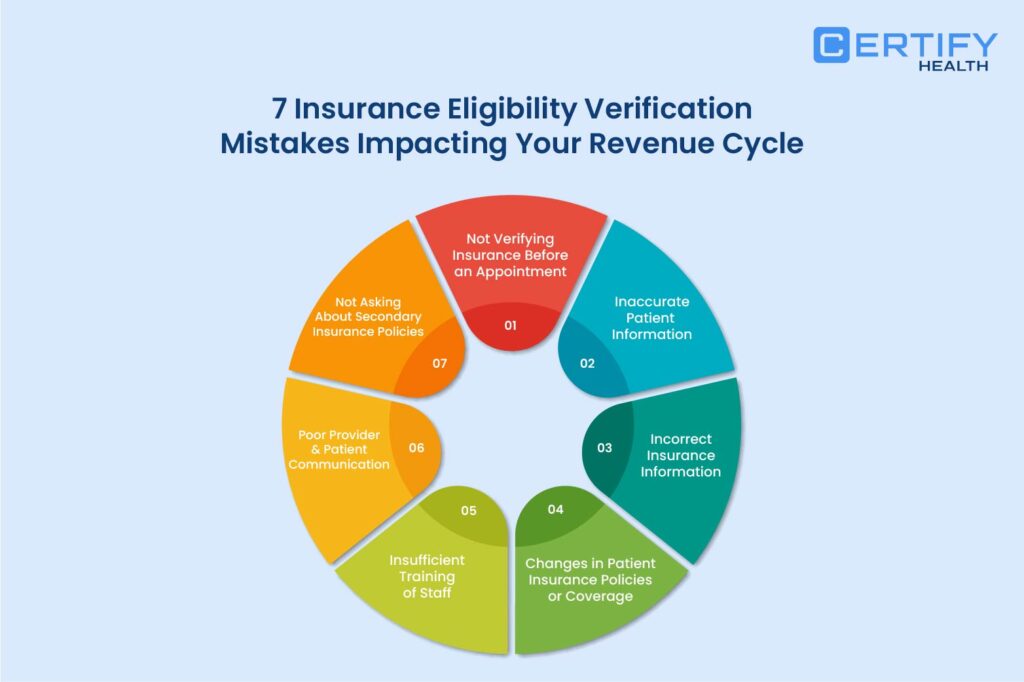Introduction
Insurance eligibility verification might sound like a mundane admin task, but in reality, it’s the financial backbone of any medical practice. When done right, everything flows—claims get approved, revenue rolls in, and no one’s pulling their hair out. But when it goes wrong? That’s when the chaos begins—denials pile up, payments slow down, and everyone’s stress levels hit new highs.
In fact, a massive chunk of claim denials begin right at the front desk—during the eligibility check. And the cost? In 2023, U.S. hospitals spent over $25.7 billion just on managing claim disputes. What’s worse? Nearly 70% of those denials were later overturned. That’s a whole lot of money and effort wasted on errors that could’ve been avoided from the start.
In this guide, we’ll walk you through seven common insurance eligibility verification mistakes that might be quietly draining your revenue. More importantly, we’ll show you how to fix them—before your practice ends up in denial overload (literally).
7 Potential Issues in Insurance Eligibility Verification

1. Not Verifying Insurance Before an Appointment
Consequences of Delayed Verification
One of the easiest ways to invite chaos into your revenue cycle? Skipping insurance eligibility verification before a patient’s appointment. It might seem like a tiny oversight, but delayed verification can trigger a full-blown billing disaster.
Imagine finding out after the appointment that the patient’s coverage had expired—or worse, never included the service at all.
Suddenly, you’re staring at a denied claim, a frustrated front desk, and a very surprised patient holding an unexpected bill.
When you verify coverage after providing care, you’re basically gambling with your revenue. It’s like doing trust falls with no one behind you. Getting it right the first time not only saves you from financial headaches, but also keeps your patients happy and your admin team sane.
Prevention Strategies
When you check coverage before the appointment, you’re not just avoiding billing surprises —you’re spotting potential hiccups early and dealing with them like a pro. Tools like CERTIFY Health’s insurance verification software make this even easier by taking the manual work off your plate and automating the whole process. (Yes, finally some tech that actually saves time!)
The best part? Early verification means you can give patients a heads-up about their financial responsibilities before they get that surprise bill. It builds trust, boosts satisfaction, and keeps the revenue cycle humming along smoothly. Fewer rejections, fewer headaches, and way less “we’ll get back to you” follow-up calls. Win-win.
2. Inaccurate Patient Information
Common Errors and Their Impact
It’s wild how inaccurate patient information such as small typho can snowball into a full-blown billing nightmare. A misspelled name here, a wrong digit there, or an address from two moves ago—and suddenly, your claim hits a wall. These tiny patient info slip-ups might seem harmless, but they can bring your revenue cycle to a screeching halt.
Insurance eligibility verification is only as good as the data it’s based on. Feed it the wrong details, and even the most high-tech system will spit out inaccurate results. And when those claims get rejected? Your team ends up playing detective—chasing down errors, making corrections, and resubmitting paperwork. All that time and energy? Yeah, it could’ve been spent doing literally anything more productive.
Prevention Strategies
Keeping patient data clean and error-free doesn’t have to feel like a constant battle. It all starts with rock-solid intake procedures. Tools like CERTIFY Health’s patient intake software make life way easier by validating info in real time—so you’re not left guessing if “Jonh Smith” was supposed to be “John.” Say goodbye to mystery typos and mismatched data.
Want to step it up a notch? Add a double-check system for critical info like names, DOBs, and insurance IDs. And don’t forget to refresh patient info at every check-in—it’s the healthcare version of “measure twice, cut once.” These small steps create big wins by catching errors early, keeping your eligibility verification smooth, and making sure your revenue cycle doesn’t hit a snag over something as silly as a missing digit.
3. Incorrect Insurance Information
Types of Errors
Insurance info mistakes—yeah, they’re kind of a big deal. We’re talking wrong policy numbers, outdated group codes, or flat-out confusion over what’s actually covered. And let’s be honest, insurance plans aren’t exactly simple these days. With different tiers, network rules, and all kinds of fine print, it’s easy to get tripped up if the details aren’t spot-on.
Mess up these details during the eligibility check, and you’re basically sending that claim off to be denied. And when that happens, it’s not just a paperwork headache—it’s delayed revenue, added admin work, and a lot of time spent untangling the mess. In short: one wrong number, and your whole billing flow hits a speed bump. Definitely not worth the risk.
Prevention Strategies
When it comes to insurance eligibility verification, double-checking isn’t optional—it’s your new best friend. Whether you’re squinting at a physical insurance card or breezing through a digital one, every detail matters. From the insurance company name to the policy and group numbers, and even who’s actually insured—it all needs to line up perfectly.
Want to avoid those pesky claim rejections? Standardized protocols are your secret weapon. Think of them like a cheat sheet for accuracy: detailed checklists that guide your team through every critical insurance detail. When everyone follows the same smart process, mistakes don’t stand a chance—and your revenue cycle stays blissfully drama-free.
Real-Time Verification Benefits
Real-time insurance verification is like giving your billing team superpowers. Instead of waiting around or making endless calls, you get instant answers—right when you need them. With just a few clicks, automated systems can confirm if a service is covered, what the patient will owe, and whether you need to jump through any pre-authorization hoops.
It’s not just fast—it’s smart. Real-time insurance verification tools help you submit clean claims the first time around, keeping your revenue flowing and your admin team from playing claim-rejection whack-a-mole. Say goodbye to the guesswork and hello to smooth, accurate, and drama-free billing.
4. Changes in Patient Insurance Policies or Coverage
Potential Issues
Insurance policies love to keep things interesting—and by interesting, we mean constantly changing. One month it’s a new co-pay, the next it’s a totally different network, and sometimes the entire plan does a disappearing act. If your practice isn’t updating patient insurance info regularly, you’re basically sending claims into the denial zone.
That’s why staying sharp with eligibility checks is non-negotiable. Patient insurance changes can sneak in during open enrollment, or when life throws in a twist—like a new job, a wedding, or a sudden “I do” turning into “I don’t.” Without a system to catch these patient insurance changes, your claims could get kicked back for using yesterday’s info in today’s world.
Real-Time Checks
Want to stop coverage-related claim denials in their tracks? Make real-time insurance eligibility verification your pre-visit ritual. By checking policy details before the patient even walks through the door, you’re working with the most up-to-date info—no surprises, no last-minute scrambles. These smart systems instantly flag any mismatches so your team can fix them on the spot.
And here’s a pro move: don’t just trust the tech—talk to your patients too. Ask about any recent changes during scheduling and check-in. That combo of automation plus a quick human check-in? It’s your best defense against denied claims caused by outdated info hiding in plain sight.
5. Inadequate Training of Staff
Importance of Training
Behind every smooth insurance eligibility verification is a well-trained staff member who knows their stuff. Seriously, training isn’t just a nice-to-have—it’s the secret sauce to avoiding costly mistakes. Without it, you get patchy processes, overlooked details, and a spike in claim denials that no one wants to deal with.
Your team needs more than just a surface-level understanding. They should know the ins and outs of different insurance plans, how to spot red flags in verification responses, and when something just doesn’t look right. And that kind of sharp eye? It only comes from solid, ongoing training—because in the world of healthcare billing, guesswork just doesn’t cut it.
Training Recommendations
Great insurance eligibility verification doesn’t happen by accident—it starts with great training. Your staff needs more than a quick onboarding session. Think ongoing education that keeps them sharp on workflows, tech tools, and all that ever-changing insurance lingo. Regular refreshers ensure they’re always up-to-date, whether it’s new policies, updated regulations, or internal process tweaks.
Want to make training actually stick? Ditch the dry lectures. Go for hands-on roleplays, real-life case studies, and situations they’ll actually face at the front desk. And once the training’s over, don’t leave them hanging—detailed checklists and cheat sheets go a long way in making sure accuracy becomes second nature.
6. Poor Provider Patient Communication
Communication Challenges
A lot of insurance hiccups start with one simple thing: communication challenges. If patients aren’t sure what info they need to share—or why it even matters—they might skip over key coverage details. And when staff don’t clearly explain the fine print, patients can end up blindsided by bills they weren’t expecting.
From network limitations to pre-authorizations, there’s a lot to get lost in translation. These provider patient communication challenges can snowball into denied claims and awkward “why wasn’t I told?” conversations. At the end of the day, clear and consistent communication isn’t just polite—it’s essential for protecting both your revenue and patient trust.
Improvement Strategies
Clear, effective communication is essential for preventing insurance misunderstandings and ensuring patients aren’t surprised by unexpected bills. Here are proven strategies to bridge communication gaps between staff and patients:
- Use Plain Language: Avoid medical jargon when discussing insurance coverage, network limitations, and pre-authorizations.
- Ask Open-Ended Questions: Encourage patients to share their concerns and clarify their understanding by asking questions like, “What questions do you have about your coverage?” or “Can you tell me what you understand about your insurance benefits?”
- Practice Active Listening: Give patients your full attention, maintain eye contact, and listen without interruption.
- Follow Up After Visits: Send a summary of coverage details, next steps, or billing expectations through patient portals or email.
7. Not Asking About Secondary Insurance Policy
Impact on Billing
Missing a patient’s secondary insurance policy might not seem like a big deal—until you realize it’s costing your practice money and your patient’s peace of mind. When that extra layer of coverage gets overlooked, you’re leaving potential reimbursements on the table and possibly charging patients for amounts their secondary plan should’ve covered.
It’s a lose-lose: your revenue takes a hit, and patients get frustrated footing bills they shouldn’t be paying. To make things worse, staff are left chasing down corrections after the fact—adding extra steps to an already busy day. Catching secondary insurance upfront? It’s a small detail that makes a huge difference.
Solutions
The easiest fix for secondary insurance slip-ups? Just ask. Seriously, making “Do you have a secondary insurance?” a standard question during intake and check-in can save your practice a world of trouble. Whether it’s on a digital form or part of a friendly front-desk chat, that one question helps catch coverage you might otherwise miss.
Your verification system should have a dedicated space for secondary details—and workflows that actually check them. And don’t forget to train your team on the usual suspects: Medicare patients with supplemental plans, kids with double coverage, and anyone juggling multiple policies. Spotting these scenarios early means fewer billing headaches later.
Conclusion: Strengthening Your Revenue Cycle
And there you have it—seven sneaky insurance eligibility verification mistakes that can quietly drain your revenue and test your team’s patience. Whether it’s delayed checks, outdated info, or that pesky forgotten secondary insurance, each misstep creates waves that rock your revenue cycle.
The good news? These mistakes are totally fixable. With the right processes (and smart tools like CERTIFY Health), what used to be a pain point can become a powerhouse. You’ll see fewer denials, faster payments, and happier patients who aren’t blindsided by surprise bills.
Let’s be real—clean claims = clean cash flow. Optimizing your eligibility verification doesn’t just help you sleep better at night; it saves time, slashes admin costs, and strengthens the entire financial backbone of your practice.
So the next time you think of eligibility checks as just another checkbox, think again. It’s not just paperwork—it’s a strategic move for revenue resilience and patient trust. Treat it like the MVP it is, and watch your practice thrive.
Next Step, Read Our Blog on 5 Expert Tips to Achieve 100% Accurate Patient Insurance Eligibility Verification











